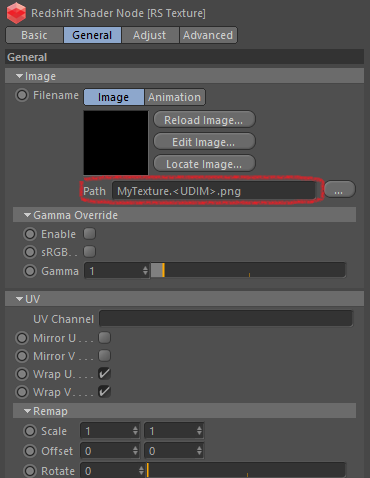Table Of Contents
Introduction
UDIM and UVTILE define efficient standards for tiling multiple textures over a mesh instead of requiring a single giant texture. Unwrapped uv coordinates are split into 'patches' that represent different regions of the mesh that require different textures.
UDIM Description
UDIM is the tiling format of Mari, was invented by Weta Digital and stands for U-Dimension.
UDIM patches have a maximum U index of 10, with virtually unlimited V index and the UDIM texture index is computed as 1001 + v*10 + u. The table below shows how UDIM indexing is conceptually laid out over 10x5 uv patch grid:

Once you have your uv map range, you need to name your texture files so they are compliant with the tiling format, for each UDIM patch index accordingly.
Below shows an example naming for three textures occupying the (0,0)->(1,0), (0,1)→(1,2) and (5,2)→(6,3) uv patches respectively :
MyTexture.1001.png
MyTexture.1011.png
MyTexture.1026.png
It does not matter where the UDIM index is placed within the filename, as long as that is the only difference between the texture names.
UVTILE Description
UVTILE is the tiling format used by Mudbox and is slightly simpler to understand. It does not have any limits in the u and v dimensions for defining the patch range. As with the UDIM format, the texture files for the patches must be named appropriately.
Below shows an equivalent example for three textures occupying the (0,0)->(1,0), (0,1)→(1,2) and (5,2)→(6,3) uv patches respectively :
MyTexture_u1_v1.png
MyTexture_u1_v2.png
MyTexture_u6_v3.png
How To Use
Once you have your tiled uv map on your meshes and have the texture files named appropriately, you will need to hint to Redshift that the textures should be sampled in this special tiled format.
In the texture sampling shader nodes, you insert an appropriate tag in place of the tile patch location on the file name, like so:
MyTexture.<UDIM>.png - for UDIM texture tiling
MyTexture<UVTILE>.png - for UVTILE texture tiling

Known Limitations
Currently Redshift can not filter texture samples across tile neighbors. This limitation will be addressed in a future release.